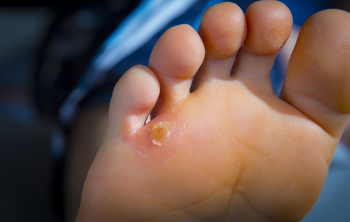Items filtered by date: October 2022
Healing Time for a Broken Ankle

Common ways an ankle can be broken include twisting the ankle beyond its limit or enduring a foot injury. There are noticeable symptoms that accompany a broken ankle. Many people are unable to walk with this type of injury, and there is often immediate pain felt and bruising. In severe breaks, a bone may become displaced where it can look deformed. If a broken ankle is suspected, a proper diagnosis is needed. Generally, this includes having an X-ray taken. Treatment can begin with placing the affected foot in a protective cast or boot, which is a successful method that helps the patient keep weight off the foot. A broken ankle can take up to approximately 12 weeks to completely heal, at which time full range of motion is often restored. A displaced ankle bone may require surgery that can help to put the bone back into its normal position and with this, a longer recovery time may be needed. If you have fractured your ankle, it is advised that you consult a podiatrist who can guide you toward the treatment that is best for you.
Broken ankles need immediate treatment. If you are seeking treatment, contact one of our podiatrists from Ankle and Foot Centers of Missouri, P.C.. Our doctors can provide the care you need to keep you pain-free and on your feet.
Broken Ankles
A broken ankle is experienced when a person fractures their tibia or fibula in the lower leg and ankle area. Both of these bones are attached at the bottom of the leg and combine to form what we know to be our ankle.
When a physician is referring to a break of the ankle, he or she is usually referring to a break in the area where the tibia and fibula are joined to create our ankle joint. Ankles are more prone to fractures because the ankle is an area that suffers a lot of pressure and stress. There are some obvious signs when a person experiences a fractured ankle, and the following symptoms may be present.
Symptoms of a Fractured Ankle
- Excessive pain when the area is touched or when any pressure is placed on the ankle
- Swelling around the area
- Bruising of the area
- Area appears to be deformed
If you suspect an ankle fracture, it is recommended to seek treatment as soon as possible. The sooner you have your podiatrist diagnose the fracture, the quicker you’ll be on the way towards recovery.
If you have any questions, please feel free to contact our offices located in the Greater Kansas City area . We offer the newest diagnostic and treatment technologies for all your foot care needs.
Let the Expert Treat Your Ingrown Toenails
Do You Have Aching Feet While Working?

The feet can feel tired and achy while standing for the majority of the work day. Practicing good foot care may help to reduce aches and pains, and this can be accomplished by wearing shoes that fit properly. Wearing compression socks may be beneficial in providing comfort to the feet and ankles. Research has shown that specific work shoes can provide good arch support, which may help reduce weakness in the feet and ankles. It is beneficial to buy appropriate work shoes at the end of the day when the feet are at their largest. Many people feel better when they can stretch or walk for short periods during the day, and this can help to improve circulation. If the profession allows it, elevating the feet can help to reduce pressure on the ankles, and it often feels good when the foot is rolled on a tennis ball. It is important to stand on a stress mat as this is generally effective in diminishing existing foot pain. If you would like additional information about how to care for your feet while working, please consult with a podiatrist.
While working on the feet, it is important to take the proper care of them. For more information about working on your feet, contact one of our podiatrists from Ankle and Foot Centers of Missouri, P.C.. Our doctors will treat your foot and ankle needs.
Working on Your Feet
Standing on your feet for long periods of time can cause stress and pain in your feet. Your whole body may experience change in terms of posture, back pain, bunions, callouses and or plantar warts. There are ways to avoid these conditions with proper foot care, smart choices and correct posture.
Positive Changes
Negative heeled shoe – Choosing this shoe type places the heel slightly lower than the ball of the foot. These are great for overall foot health. Find shoes that fit you correctly.
Go barefoot – Our feet were not designed to be enclosed for all hours of the day. Try to periodically expose your feet to air.
Eliminate Pain
Foot Exercises – Performing simple exercises, incorporating yoga and doing stretches are beneficial. This will allow increased blood flow to the area and muscles of the foot.
Achilles tendon – Stretching the foot out flat on the floor will relax the calf muscles and tendon. These exercises can be performed almost anywhere. Make sure you add these exercises to your daily regimen.
With a little bit of this information and knowing more about foot health, you will notice changes. Foot stretches and proper footwear will help with pain and prevent further issues.
If you have any questions please feel free to contact our offices located in the Greater Kansas City area . We offer the newest diagnostic and treatment technologies for all your foot and ankle needs.
Can Children and Teenagers Suffer With Gout?

Gout is a type of inflammatory arthritis that leads to pain and swelling in and around joints. It is much more common in adults but can affect children and teens as well. Gout affecting this younger age group is referred to as pediatric gout. With gout, excess uric acid in the blood builds up in the joints and forms sharp crystals to form in joints. The joints may become painful, swollen, and stiff. This condition usually starts in the big toe. Given how rare gout is in children, it is often thought to be from an underlying medical problem. This affliction can occur at birth or be associated with obesity, down syndrome, congenital heart disease, or kidney disease among other things. Male children experience a more sudden rise in uric acid levels at around age 12 compared to similarly aged females. This may be due to rising testosterone levels in males, which gives rise to increased uric acid. In contrast, rising estrogen levels in females cause an increase in uric acid removal. Increased uric acid levels may or may not lead to gout. If your child is complaining of big toe joint pain, it is suggested that you see a podiatrist as soon as possible to see if gout is the culprit.
Gout is a foot condition that requires certain treatment and care. If you are seeking treatment, contact one of our podiatrists from Ankle and Foot Centers of Missouri, P.C.. Our doctors will treat your foot and ankle needs.
What Is Gout?
Gout is a type of arthritis caused by a buildup of uric acid in the bloodstream. It often develops in the foot, especially the big toe area, although it can manifest in other parts of the body as well. Gout can make walking and standing very painful and is especially common in diabetics and the obese.
People typically get gout because of a poor diet. Genetic predisposition is also a factor. The children of parents who have had gout frequently have a chance of developing it themselves.
Gout can easily be identified by redness and inflammation of the big toe and the surrounding areas of the foot. Other symptoms include extreme fatigue, joint pain, and running high fevers. Sometimes corticosteroid drugs can be prescribed to treat gout, but the best way to combat this disease is to get more exercise and eat a better diet.
If you have any questions please feel free to contact our offices located in the Greater Kansas City area . We offer the newest diagnostic and treatment technologies for all your foot and ankle needs.
Possible Reasons Why Corns Develop

A corn is a small area of skin that hardens to protect the skin from excessive pressure that gradually forms on the foot from friction. This friction comes from wearing shoes or socks that do not fit correctly. A common place for a corn to develop is the side of the pinky toe. As small as it is, it can be extremely painful, and may make completing daily activities difficult to do. Additional reasons why a corn can appear may include standing for long periods of time, or if the feet are constantly sweaty. Corns that are found between the toes are referred to as soft corns, and are so named for the moisture that is found there. Seed corns develop on the soles of the feet, and are often found in clusters. Temporary relief may be found when a protective covering is worn over the corn, until a podiatrist is contacted. This is the type of doctor who can determine what the best course of treatment is, which may include surgery for permanent removal. If you have a corn on your foot, please consult with a podiatrist as quickly as possible who can effectively evaluate and treat the condition.
Corns can make walking very painful and should be treated immediately. If you have questions regarding your feet and ankles, contact one of our podiatrists of Ankle and Foot Centers of Missouri, P.C.. Our doctors will treat your foot and ankle needs.
Corns: What Are They? And How Do You Get Rid of Them?
Corns are thickened areas on the skin that can become painful. They are caused by excessive pressure and friction on the skin. Corns press into the deeper layers of the skin and are usually round in shape.
Ways to Prevent Corns
There are many ways to get rid of painful corns such as:
- Wearing properly fitting shoes that have been measured by a professional
- Wearing shoes that are not sharply pointed or have high heels
- Wearing only shoes that offer support
Treating Corns
Although most corns slowly disappear when the friction or pressure stops, this isn’t always the case. Consult with your podiatrist to determine the best treatment option for your case of corns.
If you have any questions please feel free to contact our offices located in the Greater Kansas City area . We offer the newest diagnostic and treatment technologies for all your foot and ankle needs.

